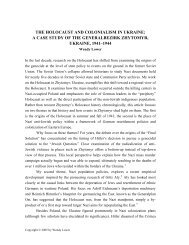Effects of Teachers' Mathematical Knowledge for Teaching on - Apple
Effects of Teachers' Mathematical Knowledge for Teaching on - Apple
Effects of Teachers' Mathematical Knowledge for Teaching on - Apple
You also want an ePaper? Increase the reach of your titles
YUMPU automatically turns print PDFs into web optimized ePapers that Google loves.
382<br />
Table 2<br />
Instrument Resp<strong>on</strong>se Rates<br />
2000–2001 2001–2002 2002–2003<br />
Type <str<strong>on</strong>g>of</str<strong>on</strong>g> No. Rate No. Rate No. Rate<br />
instrument completed (%) completed (%) completed (%)<br />
Self-administered teacher 1,806 69 2969 73 2,861 76<br />
questi<strong>on</strong>naire<br />
Teacher log<br />
Teacher sample: math log 172 97 519 91 — a<br />
Completed logs: filtered b 8,216 91 28,560 91 — a<br />
Parent questi<strong>on</strong>naire 1,999 85 2,877 76 — a<br />
Student instrument<br />
Terra Nova: fall 1,247 97 3,690 96 4,638 95<br />
Terra Nova: spring 2,220 96 4,897 96 4,595 97<br />
a Data from this year not used in the present analysis.<br />
b Log samples filtered by teacher refusal, student mobility, student ineligibility, and parental<br />
refusal.<br />
Measures<br />
Having described major instruments and resp<strong>on</strong>se rates, we next turn to the<br />
specific measures used in the study. We begin by describing student achievement<br />
measures and then work outward to measures <str<strong>on</strong>g>of</str<strong>on</strong>g> family, teacher, classroom,<br />
and school characteristics. Table 3 presents means and standard<br />
deviati<strong>on</strong>s <str<strong>on</strong>g>for</str<strong>on</strong>g> the measures discussed.<br />
Student Achievement<br />
The measures <str<strong>on</strong>g>of</str<strong>on</strong>g> student achievement used here were drawn from CTB/<br />
McGraw-Hill’s Terra Nova Complete Battery (<str<strong>on</strong>g>for</str<strong>on</strong>g> spring <str<strong>on</strong>g>of</str<strong>on</strong>g> kindergarten), the<br />
Basic Battery (in spring <str<strong>on</strong>g>of</str<strong>on</strong>g> first grade), and the Survey (in third and fourth<br />
grades). Students were assessed in the fall and spring <str<strong>on</strong>g>of</str<strong>on</strong>g> each grade by project<br />
staff, and scores were computed by CTB via item resp<strong>on</strong>se theory (IRT)<br />
scaling procedures. These scaling procedures yielded interval-level scores<br />
from students’ raw resp<strong>on</strong>ses. For the analyses c<strong>on</strong>ducted here, we computed<br />
gain scores from these IRT scale scores. In the case <str<strong>on</strong>g>of</str<strong>on</strong>g> the first-grade sample,<br />
we simply subtracted each student’s IRT mathematics scale score in spring <str<strong>on</strong>g>of</str<strong>on</strong>g><br />
kindergarten from their score in spring <str<strong>on</strong>g>of</str<strong>on</strong>g> first grade. For the third-grade sample<br />
(<str<strong>on</strong>g>for</str<strong>on</strong>g> which spring sec<strong>on</strong>d-grade data were not available), we subtracted<br />
the mathematics scale score in fall <str<strong>on</strong>g>of</str<strong>on</strong>g> third grade from the score in fall <str<strong>on</strong>g>of</str<strong>on</strong>g><br />
fourth grade. The result in both cases was a number representing how many<br />
IRT scale score points students gained over 1 year <str<strong>on</strong>g>of</str<strong>on</strong>g> instructi<strong>on</strong>.<br />
The Terra Nova is widely used in state and local accountability and<br />
in<str<strong>on</strong>g>for</str<strong>on</strong>g>mati<strong>on</strong> systems. Its use here, there<str<strong>on</strong>g>for</str<strong>on</strong>g>e, adds to the generalizability <str<strong>on</strong>g>of</str<strong>on</strong>g>




